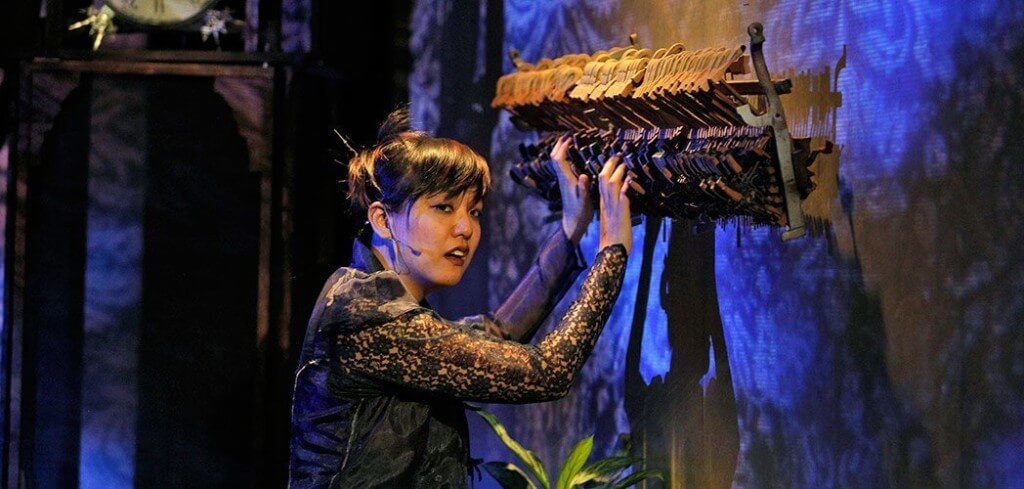Recently I was shocked to discover that the Metropolitan Opera has not programmed a woman composer since 1903—a decade and a half before women had the right to vote in America. How disappointing and discouraging for women not to see themselves represented in 112 years of archives and program notes from this, one of the preeminent musical organizations in the country. Especially when one considers that women can write and are writing operas, a fact to which the annual Prototype Festival, now in its third year, can loudly and vehemently attest.
The New York City-based opera-theater festival, run by artistic directors Kristin Marting, Beth Morrison, and Kim Whitener, presents contemporary classical chamber operas by “promising” young composers; in the past week I witnessed the work-in-progress Winter’s Child (with music by Ellen Reid and libretto by Amanda Jane Shank) as well as Korean-American artist Bora Yoon’s Sunken Cathedral, co-presented with La Mama. Both were gorgeous and haunting in their own distinct ways, and both illustrate why the Prototype Festival is so essential to the new music landscape. Perhaps most significantly, Sunken Cathedral managed to marry visuals and sounds in a manner I’ve rarely observed in multimedia works.

Bora Yoon – Photo by Cory Weaver
The music began even before I arrived, with muffled church bells ringing through the space as the audience filed into their seats. Later on in the hour-long work, when the bells struck across the vocals and other percussion, there was a sense of déjà vu, as if the sound were harkening back to a past that we could collectively feel hovering on the edge of our subconscious. Ms. Yoon’s one-woman opera, which she both composed and performed, was directed by Glynis Rigsby, with whom she conceived the work. The themes they are concerned with in Sunken Cathedral are ethereal rather than narrative: double meanings, dream symbolisms, the subconscious, and “simultaneous realities”. While acknowledging that it shares the title of a Debussy piano piece, Ms. Yoon wrote in the program notes that the sunken cathedral “in this show refers to the architecture of the subconscious, and the divine sacred which lies within each and every one of us.”
This idea of the sunken cathedral was explored with a wide range of sound and mood, with an emphasis on unexpected sounds varying from the chirps of night insects, to Korean dance and drumming artist Vong Pak’s chango drum, to a dog barking, to the clucks of struck bowls and cans crackling behind Ms. Yoon’s breathtaking singing. The astonishing visuals managed to match the music rather than detracting from it in any way, from the opening color scheme of reds and browns and maroons, to Adam Larsen’s projections of waves and jellyfish rippling across the floral background and twinkling like the night sky around Tom Lee’s sets and U-Ram Choe’s kinetic sculptures. The stunning constellation of sounds and colors included a particularly striking scene with projections of blue and white light, hazy as if viewed through squinting waterlogged eyes, and different-colored and different-pitched wind chime rods clattering again and again. While singing and ooh-ing and whispering, Ms. Yoon would drop the rods on the floor, letting a burst of bright metallic sounds fall haphazardly across the floor, then gather them back up and scatter them all over again.
Bora Yoon – Photo by Cory Weaver
But perhaps most impressive was the mirroring between the recorded sounds enveloping the theater and the objects on the stage. As the projections swirled and simmered behind dancing fish-eye silhouettes, sounds whose origins were invisible would rattle through the space, creating a sense of detachment or even unease. But many of these sounds were “explained” by visible items sitting motionless on the stage: hollow bowls and cans, a violin propped in the corner, glass, metals, a scratchy record needle, and most obviously a set of disembodied hammers along the wall, mimicking those of a piano. The final melody was played out on differently-pitched cell phone buttons, reminding us of an earlier voiceover dictating Ms. Yoon “to delete, press 7.” And of course, Ms. Yoon’s singing and piano playing was done live, complete with cell phone loops and echoes. So the line between realities was indeed blurred as we attempted to decipher what was happening in reality and what was merely an echo of the past.
The only minor drawback to an otherwise fantastic performance were the spoken texts, which felt gratuitous considering how strongly the sentiments came across via the sounds and visuals. The opening and closing voiceovers, as well as a live recited interlude, consisted of heavy-handed lines like “No one is getting out of this alone,” and were best tuned out. Yet considering Ms. Yoon’s work amid an atmosphere that seems totally deaf to the music of non-male opera composers, any flaws in her work should be regarded as minuscule details within a fundamentally stunning achievement.

